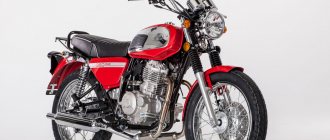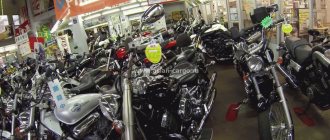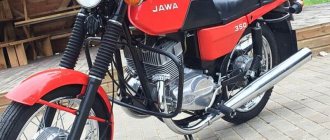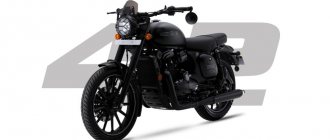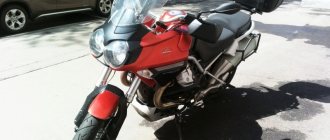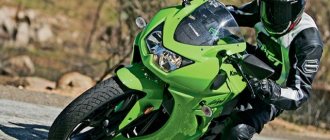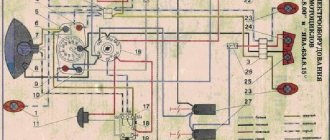Czech motorcyclesJawa motorcycles
Java 650 was very long-awaited for fans of the company.
Before it, the company produced only racing models and series in a small number of copies.
And then a magnificent representative appeared, created on the basis of the engine of the allied Austrian company Rotax. The first pilot version of the motorcycle was presented back in 2003 in the Czech Republic, where it caused a wave of emotions.
The contradictory opinions made the model the first PR campaign, which made the developers understand the genius of the project.
Java 650 retained many of its signature features, but also acquired new ones. There are several advantages of the model:
- The design of the motorcycle is created in such a way that a person can easily service it (candles, thermostat and other elements are conveniently located);
- The power unit and gearbox are pleasing with their characteristics even now, so many years after the model was released;
- The motorcycle has a simple and convenient design , and in general its execution is very successful;
The classic Jawa quality has been preserved , but the model also has several disadvantages:
- Instability of braking (the front shock absorber reaches its limit during moderate braking);
- In some phases of riding, the vibration of the engine increases (for a single-cylinder motorcycle this is natural, but the sensations are very strange while riding);
- Feedback from owners and experts conducting test drives revealed another problem: there are installation defects in the electrical equipment system (this does not create serious problems during further operation if you carefully monitor this).
Model 650 became popular not only in its homeland , as most copies were exported.
Thanks to its pleasant and simple controls, the motorcycle fell in love with the female audience. Although the men did not deprive him of attention.
What was especially pleasing about this Soviet model is that it has three variations .
Jawa 650 Classic
The Java 650 Classic, also known as the Police, defies definition.
Even the creator himself declared the model as something special and exceptional.
It comes closest to choppers, and its external characteristics interestingly combine traditional features and modern relevance.
The characteristics of the unit are perfect for travel lovers, and as an additional bonus you get an economical motorcycle with a trailed sidecar, which increases the overall load capacity significantly.
Like other motorcycles in the line, the Police is equipped with a single-cylinder Rotax Bombardier engine with a displacement of 650 cubic centimeters and a water cooling system.
The five-speed gearbox made a loud statement thanks to smooth gear changes and quiet, pleasant operation.
Safety is ensured by the semi-duplex steel body and good brakes. Jawa 650 Classic appeared earlier than its brothers, in 2004, and therefore is currently slightly outdated.
The very famous and popular at one time IZH Planet 2 - technical characteristics, description of the motorcycle you will find here.
IZH, which demonstrates excellent driving on the highway and on the roads:
Motorcycle Jawa 500R 1987 review
The description of the Jawa 500R 1987 motorcycle is in the queue for publication of the article. Announcement: Today, for almost every new motorcycle that comes into being, marketers strive to carve out their own niche. This one is a road sport, this one is a recreational enduro. But what class should we include a motorcycle that has a little bit of everything? A good bike should have a reliable engine, comfortable ergonomics and simple controls...
Jawa 500R is a motorcycle that is rarely sold in Russia and is equipped with an average power 34 hp engine. Despite the fact that good models of motorcycles have a very respectable price, and the season for their use is relatively short, the motorcycle market is developing rapidly. And if you believe the words of dealers, then some models of recently released motorcycles are selling like hot cakes at the beginning of the season, and the models brought to Russia are clearly not enough to fully satisfy consumer demand.
A motorcycle has long ceased to be an alternative to a car, and the times when this equipment was bought only because there was not enough money for a full-fledged car are forgotten. Nowadays, two-wheelers can be called technological marvels in many cases, and their cost can be compared with that of prestigious cars.
Many people have started buying motorcycles for hobby purposes as riding or even collecting them has become a good pastime for many people. Many motorcycles, for example the Jawa 500R, the technical characteristics of which make it possible to call the model a prestigious brand, are in demand among both beginners and experienced motorcyclists.
Currently, it is impossible to purchase a new Jawa 500R motorcycle from the 1987 model year, since their production stopped 29 years ago. At the same time, the Jawa 500R has excellent technical characteristics, so many people strive to purchase, if not a new, then at least a used version.
Motorcycles with an engine capacity of 481 cc. see, appeared as a result of long work of inventors who sought to create a model that was not inferior in characteristics to other versions of the motorcycle. In some cases, these models are not only not inferior, but also ahead of other motorcycles, as they have minimal fuel consumption and other excellent parameters.
Motorcycles with an engine capacity of more than 400 kb. cm, to which the Jawa 500R belongs - this category of motorcycles simply cannot claim the title of “motorcycle for a beginner.” On the contrary, this is already a serious technique that requires certain control of motorcycle equipment with a smaller engine capacity. Yes, she attracts more attention, she is the most beautiful, fast, interesting and there is a huge selection of models. But as power increases, the weight of the motorcycle inevitably increases. In this class you are unlikely to find motorcycles lighter than 180 kg, unless they are the latest motorcycle models.
Go to the entire range of Jawa motorcycles, on this page you can find Jawa 500R motorcycles from other years of production and information about them
Jawa 650 Style
The 2005 Best Product winner is beautiful, elegant and very carefully designed .
Not designed for short distance racing.
This motorcycle should completely suit your character : it is moderate, balanced, moves neatly and majestically.
The saddle is perfectly designed , you can sit on it all day long no matter what. The classic 17-liter tank will also please those who like to test their steel horse.
It is suitable for Russian users because it is designed for different climatic zones and sudden changes in weather conditions.
The main thing you should not forget is that this motorcycle was not created for off-road use . If you want to race on rough terrain, the Jawa 650 Style is not for you!
650 cc engine cm should not disappoint you.
Its power is 46 horses , the motorcycle can accelerate to 165 km/h , which is simply fantastic for its category. In the entire line, he is considered the most pampered and most beloved by developers.
Jawa Java 500cc OHC 1952
History, technical characteristics and a selection of photographs of the 1952 Jawa 500 OHC motorcycle. World War II passed, and the Jawa plant decided to put into production simpler and cheaper two-stroke motorcycles. But, a few years after the war, buyers demanded a more powerful motorcycle. (see details)
So, already in 1950, the Jawa plant produced a 500 cc engine, which in 1952 began to be installed on the new production motorcycle Jawa Java 500 OHC (Overhead Camshaft). The abbreviation in the name refers to a new four-stroke engine, which had a single camshaft located not in the cylinder block, as in the Jawa Java 500cc OHV , but in the cylinder head along with the valves. The two air-cooled cylinders had a total volume of 489 cm3 and developed a power of 19.1 kW ( 26 hp ) at 5,000 rpm.
The motorcycle has a four-speed gearbox with foot shift. The Lucas magnetic dynamo originally fitted to this motorcycle was soon replaced by a PAL 60 Watt dynamo battery ignition. The engine is lubricated by an oil pump. A 4.5-liter tank was allocated for oil. The volume of the main gas tank is 16 liters. It was to this that the single seat of the motorcycle was attached. The frame of the motorcycle was almost similar to the previous Perak model with several reinforcing struts (the possibility of a sidecar was provided). The telescopic front fork was equipped with two oil shock absorbers, while the rear wheel was sprung by sliding telescopic shock absorbers with coil springs. The weight of the motorcycle was 156 kg, and the maximum speed reached 135 km/h. Gasoline consumption , given the engine size, was very small - 4 liters per 100 km.
In 1953, the Jawa Java 500 OHC - the engine was improved: the power increased to 20.6 kW ( 28 hp ). The weight of the motorcycle also increased (up to 174 kg), but the weight did not affect the maximum speed, which was now 147 km/h . Since 1956, the 500 cc motorcycle model received a more comfortable and practical double seat . The last Jawa Java 500 OHC rolled off the assembly line in 1958 - that’s when the history of the 500 cc production Jawa Java motorcycles ended . Further, motorcycles with similar engines were developed only in single copies.
Table. Technical characteristics of Jawa Java 500 OHC
Jawa 650 Dakar
A 2006 model that was a little ahead of its time. At the time of the presentation, many began to criticize the Dakar, saying that outwardly it is an enduro tourist, but in reality it is a city bike.
And besides, angular shapes came into fashion only a year or more later.
In terms of functionality, this model has no equal in the price segment: ergonomics at the highest level, good optics, a wide and comfortable saddle, reliable brakes and a powerful motor.
In principle, this is exactly the model about which it’s not a sin to say “for an amateur .
The Jawa 650 Dakar takes some getting used to. If this is your first bike, then you will not want to part with it for a very long time.
If you are switching from a newer and more expensive bike, the sensations are much more gray.
Honda CRF1100L Africa Twin 2022 unveiled
The current iteration of the Honda Africa Twin comes in two available variants: Africa Twin and Africa Twin Adventure Sports. The latter of which was more oriented towards off-road use, having increased suspension travel, a larger fuel tank and crash bars.
Next year, the positioning of the 2020 Honda Africa CRF1100L Twin will change slightly. The “Adventure Sports” modification will become more focused on full-fledged tourism, but the standard version, on the contrary, will be more suitable for off-road use.
Both models are based on a new engine with an increased volume of up to 1084 cm³. This was achieved by increasing the piston stroke by 5 mm. In addition, the cylinder heads have been modified, where the valve lift has increased, the throttle bodies have become larger in diameter, and the new arrangement of the injectors now provides a more direct spray of fuel into the combustion chamber.
Despite the fact that there are quite a lot of improvements, power has increased slightly, from 95 to 100.5 hp, and torque has increased by 6% and is now 104.9 Nm. In general, this is exactly what the end customers asked for, because everyone complained about the lack of power, including us.
Technical characteristics of Jawa 650 models
| Jawa 650 Classic | Jawa 650 Style | Jawa 650 Dakar | |
| Engine | Rotax | Rotax | Rotax |
| Number of cylinders/valves/stroke | 1/4/4 | 1/4/4 | 1/4/4 |
| Cooling system | Liquid (water) | Liquid (water) | Liquid (water) |
| Launch on account | Electric starter | Electric starter | Electric starter |
| Volume | 651.9 cc | 651.9 cc | 651.9 cc |
| Power | 48 l. With. / 6,500 rpm | 48 l. With. / 6,500 rpm | 48.1 l. With. / 6,500 rpm |
| checkpoint | Five steps | Five steps | Five steps |
| Gearbox type | Mechanics | Mechanics | Mechanics |
| Chassis | |||
| Suspension front/rear] | Telescopic fork 36 / Adjustable shock absorbers (2 pcs) | Telescopic fork 36 / Pendulum with adjustable shock absorbers (2 pcs) | Telescopic fork / Pendulum with mono-shock absorber |
| Suspension travel front/rear | 150/80 mm | 150/80 mm | 150/170 mm |
| Front braking system | Disc with two piston calipers (320 mm) | Hydraulic disc with two piston calipers (320 mm) | Hydraulic discs with two piston calipers (320 mm) |
| Rear braking system | Disc brake (220 mm) | Hydraulic disc (220 mm) | Hydraulic disc with two piston calipers (220 mm) |
| Dimensions | |||
| L/H/W | 2.215/0.718/1.130 m | 2.215/0.718/1.130 m | 2.215/0.718/1.130 m |
| Wheelbase | 1.525 m | 1.518 m | 1.518 m |
| Saddle height | 0.712 m | 0.820 m | 0.860 m |
| Weight (curb) | 187.5 kg | 190 kg | 195 kg |
| Price of a new copy | $ 3 600 | $ 3 700 | $8 000 |
| Used price | From $200 | From $700 | There is no information due to the low popularity of the model |
A stylish bike of limited production - Ural IMZ 8.1024 Cobra, which is now a collector's dream.
The basis for the creation of this motorcycle was the Ural classic model.
MY MOTORCYCLE
Java won the hearts of Soviet motorcycle enthusiasts a long time ago and is still popular. But who knows one of the modifications of this motorcycle - Java-500. How can this Yavushka differ from the others? This motorcycle is special in that it was originally produced for racing, but........
These were unusual races - ice racing - speedway. And Java-500 has conquered them more than once and shown excellent results.
Let's start in order: in the Soviet Union, they really started talking about motorcycle racing on ice in 1938 after the appearance of steel wire spikes. The first official competitions took place on March 13, 1939 at the Moscow Hippodrome. Then 35 participants took to the start. And in 1959, the first national championship in the 125 and 350 cm/cc motorcycle classes was held at the Grand Sports Arena of the Central Stadium in Luzhniki. Thanks to the climatic conditions, ice track racing has become very popular in our country. At the initiative of the motorcycle federations of the Soviet Union, Sweden and Czechoslovakia, the International Motorsports Federation (FIM) decided to organize an “ice” championship. The first such competitions took place in 1966, and our compatriot, the outstanding athlete Gabdarakhman Kadyrov, who competed at Java, became the champion. Since then, competitions of this rank have been held annually. But the most interesting thing is that all these years the leaders have been racing to the gold medal in the saddle of the same motorcycle - the Java 500. A rare example of athletic longevity! Especially for such an older motorcycle. So what kind of motorcycle is this that has held the lead for such a long time?
The first thing that catches your eye is the studded wheels. The height of the studs is limited to 28 mm and is carefully checked by the technical commission before races. But their number and location on the tire is individual for each athlete and averages up to 120 studs on the front wheel and up to 200 on the rear wheel. The front wheel is “shod” with a tire measuring 2.75X 23″ and installed in a telescopic fork, which is borrowed from the old model of the “Ch3” motocross bike. Its stroke is limited to 100 mm, the damping is changed accordingly and air is pumped into the feathers. The rear wheel with a 3.00X21″ tire on the latest model has a cantileve suspension with a central spring element and a travel of 60 mm. For the safety of the riders, the wheels are equipped with protection in the form of a tubular frame on the front and a deep fender on the rear, and the rear chain drive is covered with a shield.
The motorcycle engine is four-stroke, single-cylinder, air-cooled, cylinder diameter/piston stroke is 85/87 mm, displacement is 496 cm3, compression ratio is 13.5-13.8, power is 56 hp. With. at 8500 rpm, maximum torque - 50 Nm, fuel - methyl alcohol (methanol). The crankshaft is mounted on roller bearings of the “Java” design. The piston is forged from an aluminum alloy and has two 1 mm thick piston rings. Classic cylinder - cast iron liner and aluminum jacket. The cylinder head is a two-valve, single camshaft driven by a chain (the previous 891 model used a two-valve head with two camshafts). In the mid-seventies, more powerful four-valve engines appeared on race tracks, which led to more frequent falls and serious injuries to athletes. Therefore, the FIM introduced a ban on the use of four-valve engines in ice racing. The engine lubrication system consists of an oil tank installed in the warmest place - behind the cylinder, and a two-section pump. Oil is supplied by a pump to the connecting rod (lower) bearing and into the cavity of the gas distribution mechanism. The splashed oil lubricates the remaining engine parts (camshaft main bearings, chain, valves, camshaft needle bearings) and flows from the lower part of the crankcase into a separate reservoir, from which it is drained after one or two runs. Due to its simplicity and high quality manufacturing, the engine is very reliable. The service life of its main parts is approximately 25 races, that is, almost a whole season.
Ignition is from a magneto. The engine is equipped with a Dell'Orto PH BE 34DS carburetor with a diffuser diameter of 34 mm (FIM limitation). The motorcycle frame is welded from high-quality pipes and has high spatial rigidity, which is especially necessary in the final races of the competition, when the ice is heavily broken by spikes. Due to the impossibility of the studded wheel slipping at the start, the motorcycle is equipped with a two-speed gearbox. First gear is used only at start. Despite the high speeds that track motorcycles develop, they do not have brakes: braking is carried out by the engine. In the event of a fall, the ignition is turned off by pulling out a chip, which is connected by a cord to the driver’s right wrist. And another characteristic feature of ice racing motorcycles: the appearance of even the most modern models is very reminiscent of their “fifty-year-old” ancestors. This is a kind of “technical reserve”, but it does not in any way reduce the entertainment and excitement of the fight.
This seemingly “nondescript” Yavushka is still in demand.
Photo gallery
We have already become familiar with the Java 650 motorcycles, which in Soviet times were considered the best available. I must say that even now they are in considerable demand. Let's look at the legend of the motorcycle industry in our small photo selection.
